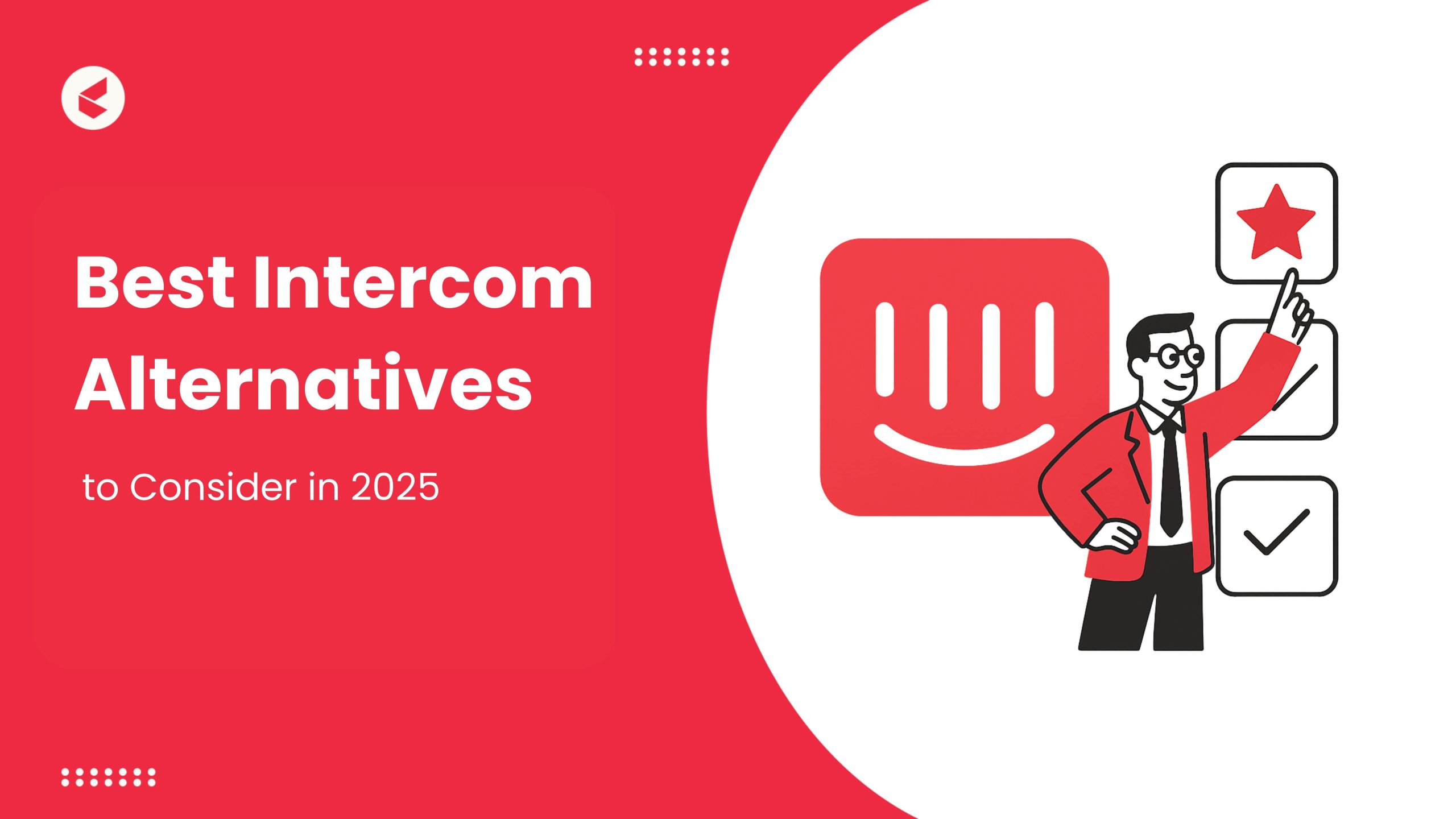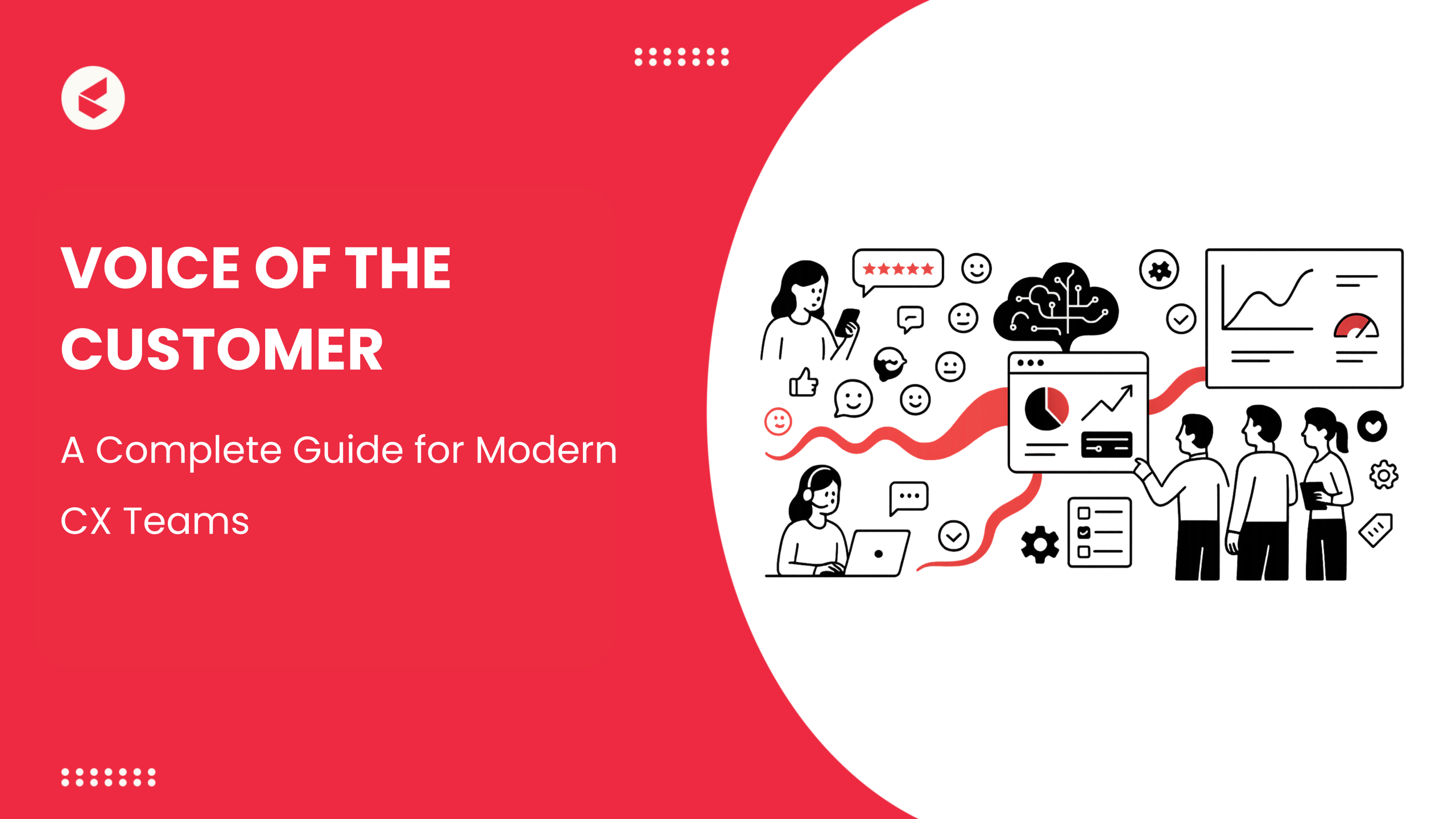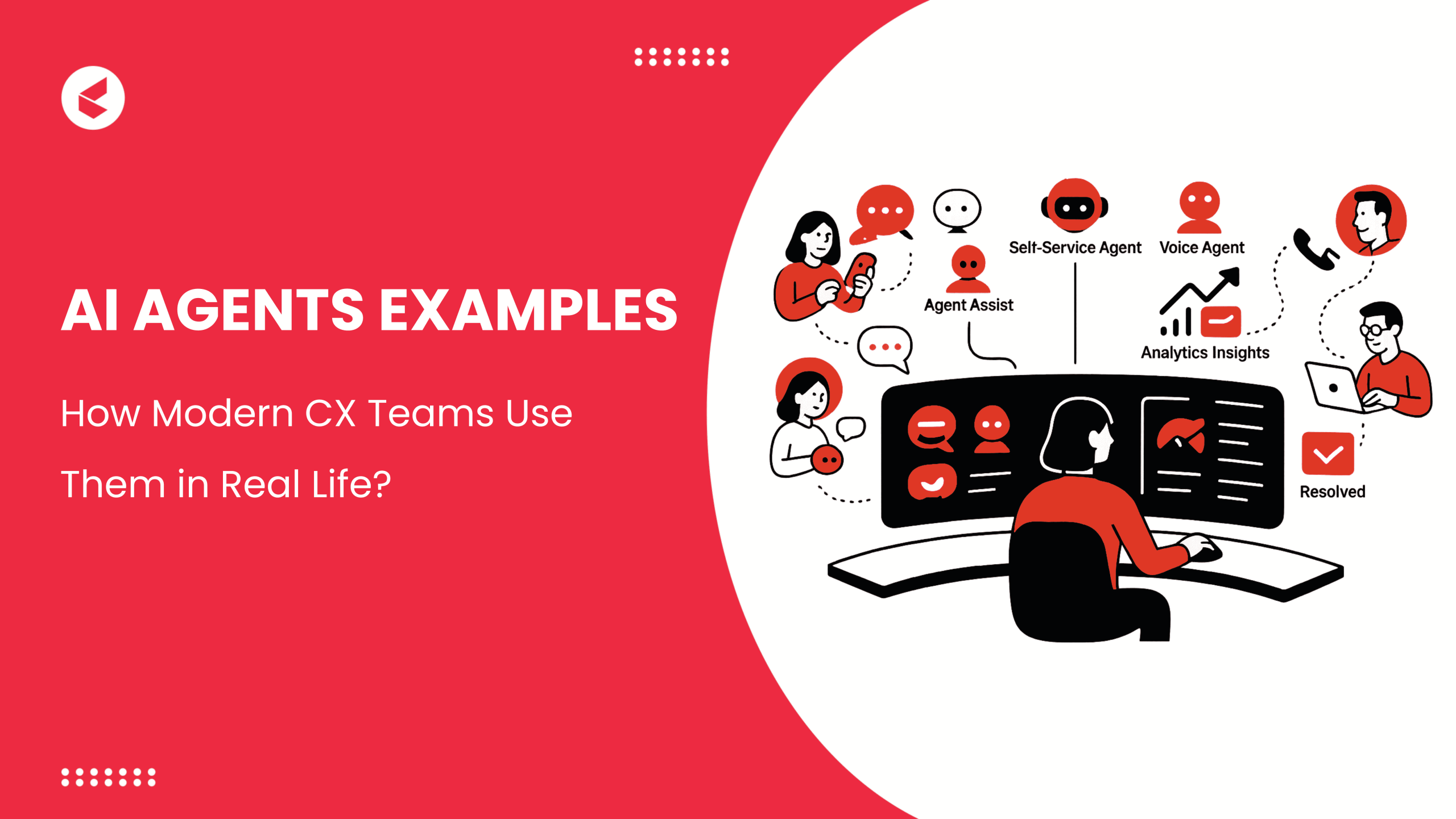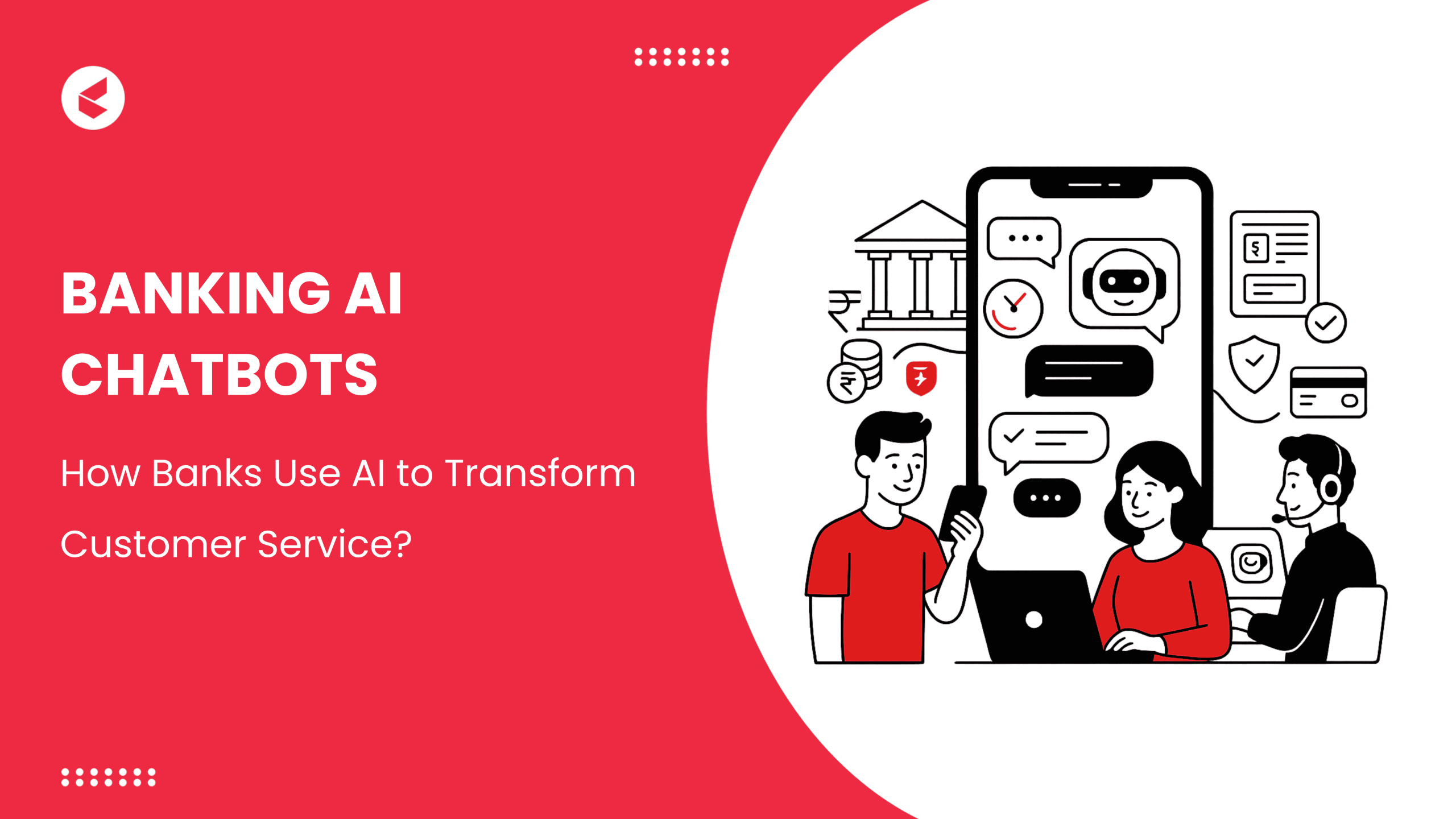When Intercom launched, it disrupted the customer support space. It introduced in-app messaging, bots, and a unified inbox—features that quickly set a new industry standard.
But as customer expectations soared and businesses scaled, the cracks began to show. Today, CX leaders demand deeper analytics, smarter automation, and reliable support. However, businesses often cite slow response times, unclear pricing, and scalability challenges when using Intercom.
As one frustrated user noted in a recent review, they experienced lack of support, high pricing, and unclear billing practices.
That’s why we’ve put together this guide to the top Intercom alternatives—15 powerful platforms that go beyond live chat. Whether you’re scaling fast or streamlining support, this comparison makes it easy to find the right customer service software for your business.
Comparison Table: Intercom vs. Top Alternatives
Below is a concise comparison of the available Intercom alternatives for quick reference.
| Tool | Key Features | Best Use Cases | Usability | Integrations | G2 Rating |
|---|---|---|---|---|---|
| Kapture CX | Omnichannel ticketing, AI automation, customer 360 view | Enterprise-level support teams needing deep custom workflows | Intuitive interface with rich customization and fast learning curve | CRM, WhatsApp, Email, API | 4.4/5 |
| Help Scout | Shared inbox, Docs, customer profiles, Beacon widget | Startups and SMBs wanting fast, human support | Clean UI that’s beginner-friendly and focused on collaboration | Slack, Shopify, Zapier | 4.4/5 |
| Freshdesk | Ticketing, SLAs, knowledge base, automation | Support teams managing large volumes with structured SLAs | Straightforward but may feel clunky with advanced features | Email, CRM, Jira | 4.4/5 |
| Gorgias | Shopify integration, macros, auto-responses | eCommerce brands handling order-related queries | Smooth for Shopify users, but limited flexibility beyond eCommerce | Shopify, Magento, BigCommerce | 4.6/5 |
| Zendesk | Ticketing, help center, live chat, AI bots | Enterprises with complex support workflows | Robust but can be overwhelming for new users | 1,000+ apps, APIs | 4.3/5 |
| LiveAgent | Universal inbox, call center, gamification | SMBs wanting a budget-friendly multi-channel tool | User-friendly but the interface feels dated | CRM, CMS, Email | 4.5/5 |
| Zoho Desk | Multichannel ticketing, AI, automation | Mid-sized businesses with growing support needs | Easy to navigate, especially for Zoho users | Zoho Suite, Slack, Telephony | 4.4/5 |
| HelpCrunch | Chat, email marketing, self-service | SaaS startups combining support with lead gen | Modern interface with a shallow learning curve | WordPress, Shopify, Zapier | 4.7/5 |
| Olark | Live chat, CRM notes, reporting | Small teams offering proactive chat-based support | Extremely easy to use, but limited advanced tools | Mailchimp, Google Analytics | 4.3/5 |
| Drift | Conversational AI, bots, scheduling | B2B brands focusing on lead qualification and support | Polished UI with a slight learning curve for bot workflows | Marketo, Salesforce, Slack | 4.4/5 |
| HubSpot Service Hub | Tickets, help desk, automation, knowledge base | Teams wanting all-in-one CRM and support | Seamless for existing HubSpot users, otherwise a bit complex | HubSpot Suite, Gmail, Outlook | 4.4/5 |
| Tidio | AI chatbot, live chat, multichannel inbox | Small eCommerce brands wanting chatbot support | Simple and clean design, ideal for non-tech users | Shopify, Messenger, Zapier | 4.7/5 |
| Kayako | Unified inbox, real-time messaging, automation | Teams needing contextual conversations across channels | Functional but less modern UI may slow adoption | Zapier, Slack, Salesforce | 4.0/5 |
| Crisp | Live chat, shared inbox, CRM, bots | Freelancers and startups seeking low-cost, all-in-one tool | Intuitive with modern visuals and easy automation setup | WordPress, WhatsApp, API | 4.5/5 |
| tawk.to | Free live chat, ticketing, knowledge base | Businesses looking for zero-cost customer chat | Extremely easy to deploy and use, even for beginners | WordPress, Wix, Shopify | 4.5/5 |
Best Intercom Alternatives in 2025
Intercom not cutting it anymore? Check out these top Intercom alternatives of 2025 built for modern CX teams.
1. Kapture CX
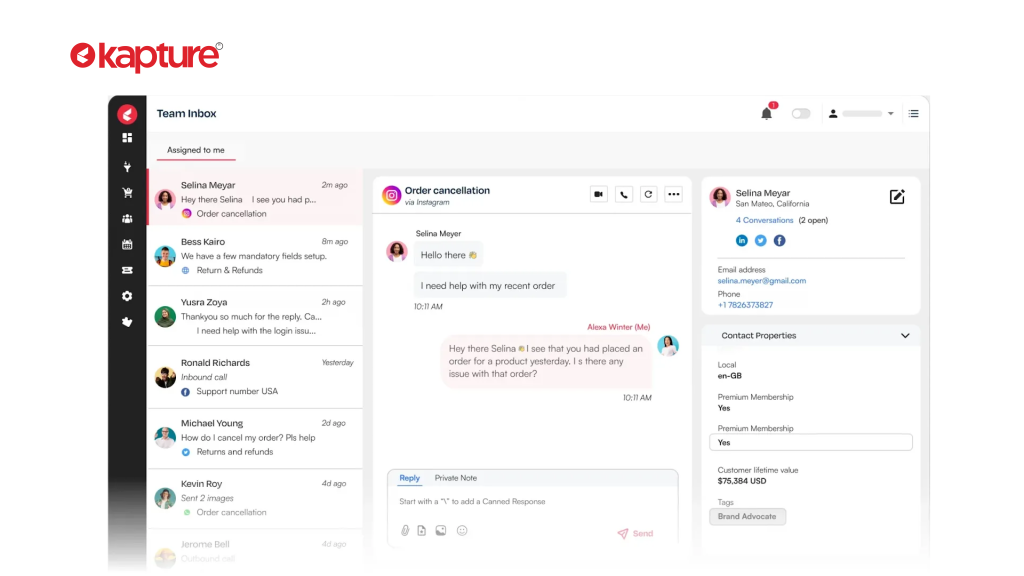
If you’re looking for a platform that goes beyond generic CX tools, Kapture CX is built just for you. With industry-specific workflows, AI-powered automation, and an intuitive interface, it delivers deeply tailored customer experiences across every channel.
Kapture molds to your operations, unlike rigid, one-size-fits-all platforms. From query deflection to advanced insights, it empowers you to drive real outcomes—faster resolutions, better CSAT, and loyal customers.
What sets Kapture apart is its AI-first architecture, designed specifically for your industry. It features Vertical AI (LLMs) trained on domain-specific data, Auto-QA for real-time agent performance assessment, and a GenAI-powered multilingual knowledge base to support customers in any language.
These tools work together to boost support quality, reduce errors, and personalize every interaction. With built-in sentiment mapping and agent insights, your team can improve outcomes at scale without guesswork.
Key Features:
- AI-powered ticket routing and auto-tagging
- GenAI-enabled multilingual knowledge base
- Omnichannel support across channels like email, live chat, voice calls, and social platforms
- AI Co-pilot for agent assistance and productivity
- Self-Serve 2.0 for instant query deflection
- Real-time sentiment analysis and conversation intelligence
- Vertical LLMs for industry-specific automation
- Smart feedback loops with auto QA and insights
Pros:
- Purpose-built AI for industry-specific needs
- Unified CX platform with 1000+ integrations
- Boosts resolution speed and customer satisfaction
Ideal Use Cases:
- Deliver hyper-personalized CX in BFSI, retail, or healthcare
- Free up agent time by automating repetitive, low-value tasks
- Improve decision-making with deep CX insights
- Empower customers with intelligent self-service
2. Help Scout
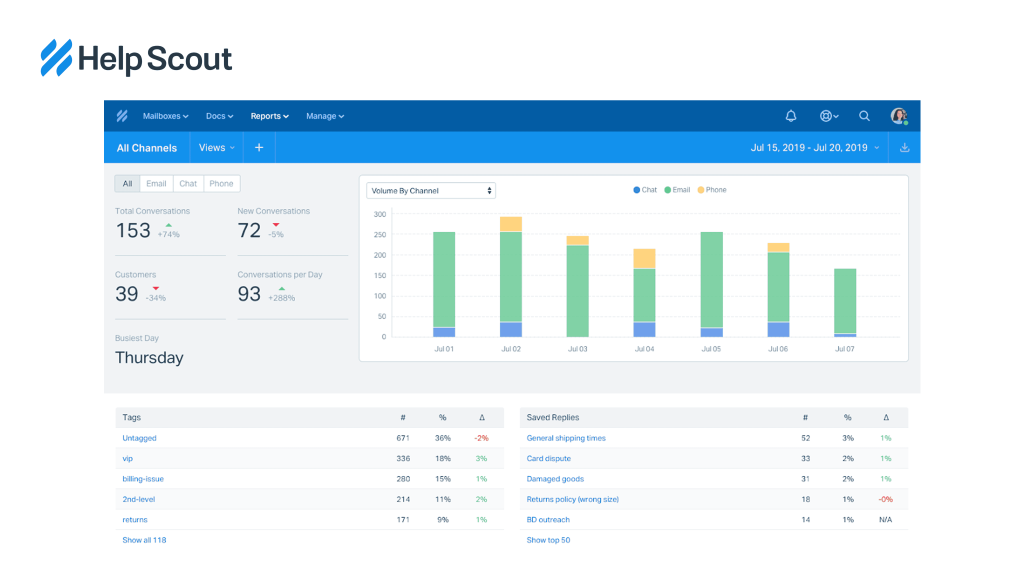
Help Scout is a customer support software that resembles email while operating like a comprehensive help desk. It’s straightforward, neat, and easy for your team to embrace.
In addition to the fundamentals, Help Scout provides Beacon, an integrated widget that merges live chat, self-service options, and proactive support prompts—all within your application or website. Beacon lets you surface help articles contextually based on user behavior, reducing friction and increasing resolution without agent involvement.
With a focus on customer intimacy, Help Scout enables faster responses and better collaboration. However, its simplicity can sometimes limit large-scale customization—making it less ideal for complex enterprise environments.
Key Features:
- Shared inbox for team collaboration
- In-app messaging and live chat
- Docs for self-service support
- Customer profiles with interaction history
- Workflow automation and tagging
- Reporting on team performance and ticket trends
- Integrations with 100+ tools (e.g., Slack, Salesforce)
- Mobile apps for on-the-go support
Pros:
- A sleek, user-friendly layout that anyone can navigate with ease
- Strong collaboration features for small teams
- Emphasizes personalized, human-first support
Ideal Use Cases:
- Manage customer emails in a fast-paced startup
- Create a searchable self-service hub to answer customer queries instantly
- Add live chat support during peak business hours to assist visitors in real time
- Collaborate internally on tickets with context-rich notes
3. Freshdesk
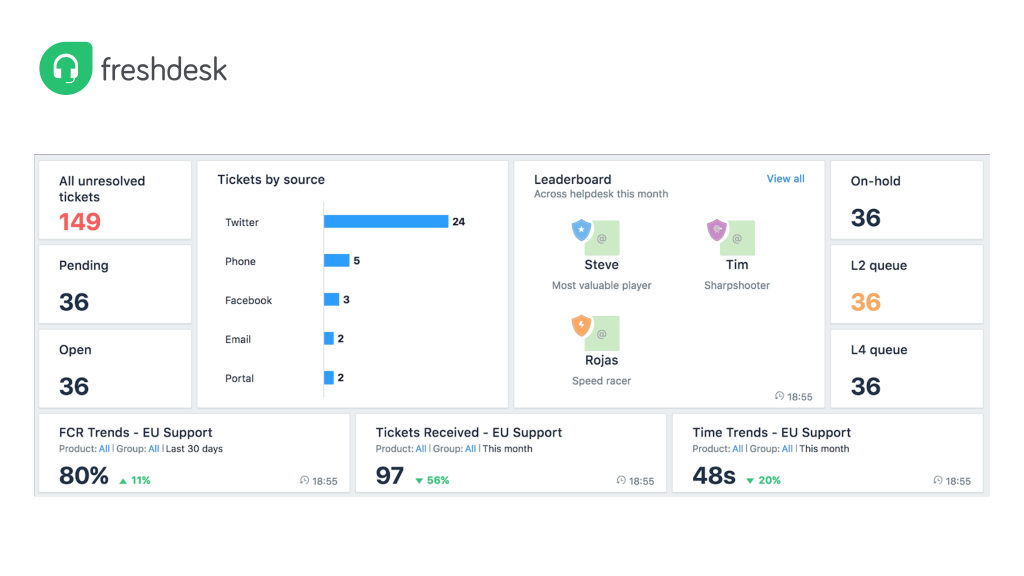
Freshdesk is a comprehensive cloud-based support platform designed for companies wanting to consolidate their customer service functions in one place. Crafted with an intuitive interface, it assists you in handling customer dialogues on a large scale.
A notable feature is its minimal learning curve, allowing teams to start quickly without requiring extensive technical knowledge. You can easily streamline support with minimal training. The AI-powered Freddy assistant boosts productivity by automating repetitive tasks and offering intelligent suggestions, while the built-in knowledge base supports self-service to reduce ticket volume.
Despite its versatility, Freshdesk can feel somewhat restricted in its more basic plans, especially for organizations that require advanced customization or highly granular reporting. These capabilities are often locked behind premium tiers, which might not be feasible for every business.
Key Features:
- Multichannel support: email, chat, phone, and social platforms
- Team inbox with AI-powered ticket assignments
- Freddy AI offers instant suggestions, smart replies, and data-backed insights
- Built-in knowledge base and forums
- Custom automation for SLAs and workflows
- CSAT surveys for real-time feedback
- Reporting dashboards and analytics
- Marketplace with 1,000+ app integrations
Pros:
- Intuitive UI makes onboarding quick
- Excellent for multichannel support
- Scenario automation to apply multi-action triggers
- Gamification tools to improve agent motivation
Ideal Use Cases:
- Manage customer support across channels
- Build an AI-enabled help center
- Set up smart routing for large teams
- Gather customer feedback post-resolution
4. Gorgias

If you’re running an eCommerce store and want to centralize customer service, Gorgias could be your go-to tool. It’s built specifically for online retailers, with native integrations for Shopify, Magento, and BigCommerce. You can manage customer queries from email, live chat, social media, and SMS—all in one unified dashboard.
Gorgias stands out with its automation rules that tag, route, and respond to repetitive tickets, helping you save time while staying personal. It also pulls customer data—like order history and tracking—from your store, so agents can reply faster with more context.
Nevertheless, Gorgias may not be ideal if you’re outside the eCommerce space, as many of its features are heavily retail-focused. Also, for smaller teams, the pricing can escalate quickly as volume grows.
Key Features:
- Centralized support across email, chat, Instagram, and more
- Deep integration with major eCommerce platforms
- Auto-responses and intent-based ticket routing
- Rule-based automation for repetitive tasks
- Macros and templated replies for speed
- Customer context appears directly within each ticket for faster handling
- Live chat with real-time visitor data
- Revenue tracking linked to customer interactions
Pros:
- Designed specifically for eCommerce teams
- Reduces response time with automation
- Supports omnichannel ticketing
- Displays order and shipping info instantly
Ideal Use Cases:
- Shopify or Magento stores needing omnichannel support
- Customer service teams handling high volumes of repetitive queries
- Brands wanting order-based personalization in support
- Online stores tracking revenue from support channels
5. Zendesk

Zendesk is a powerhouse in the customer service space, trusted by large-scale enterprises to manage complex support environments with global reach. It provides a flexible infrastructure capable of handling multi-brand, multilingual, and multi-channel support through a unified interface.
The system is built to scale, making it particularly valuable for organizations juggling high ticket volumes, varied workflows, and geographically dispersed teams. With advanced AI tools, automation capabilities, and deep integration options, Zendesk empowers teams to personalize interactions while maintaining operational efficiency.
Nonetheless, if you’re a small or mid-sized business, the pricing structure and feature tiering may introduce limitations. You may find Zendesk’s advanced features locked behind expensive plans, making it less budget-friendly for lean teams.
Key Features:
- Consolidated ticketing from email, chat, phone, and social platforms
- AI-powered bots and automation workflows
- Integrated help center and community forums
- Context-rich customer profiles and conversation histories
- SLA management and performance tracking
- Multi-brand support from a single dashboard
- Customizable reporting with real-time analytics
- Marketplace with 1,500+ integrations
Pros:
- Scales well for complex support operations
- Strong analytics and automation capabilities
- Ideal for global or multi-brand teams
- Role-based access for granular permissions
- Sandbox environment for testing configurations
Ideal Use Cases:
- Manage high-volume, multi-channel support requests
- Build a customised help center so customers can find answers independently
- Leverage AI to reduce ticket resolution time
- Support global teams with multi-language workflows
6. LiveAgent
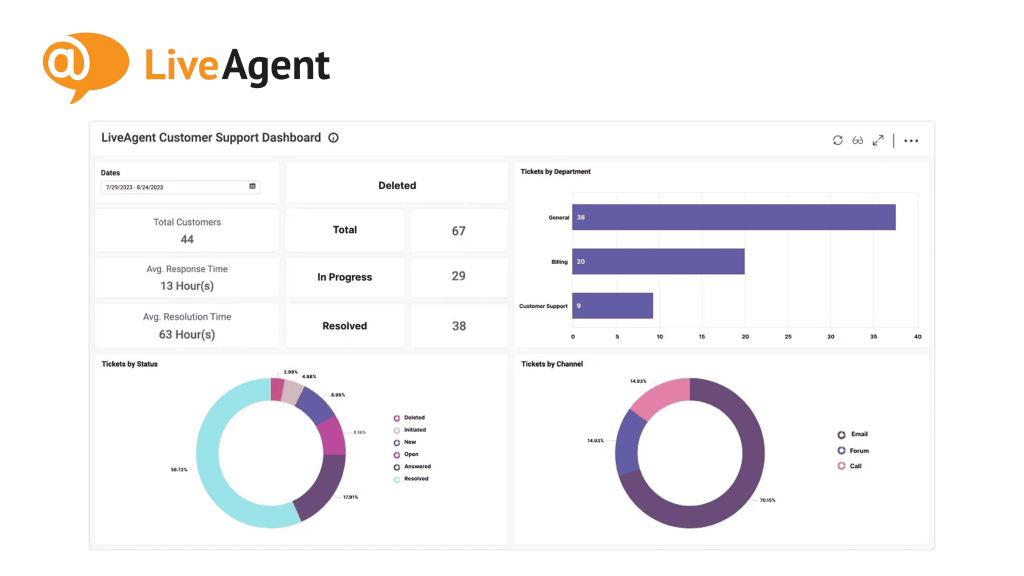
LiveAgent focuses on performance and simplicity, offering a streamlined support tool without the clutter. It’s particularly appealing for growing teams or eCommerce businesses that want to ramp up support quickly without a steep learning curve.
A key differentiator lies in its comprehensive ticketing system and “universal inbox,” where customer queries from various channels are transformed into organized conversations. But while it excels in live chat, phone, and ticketing, you might find its reporting and analytics less robust compared to more enterprise-focused solutions.
Key Features:
- All interactions—from email to chat—flow into a central inbox
- Real-time live chat with proactive chat invitations
- Call center integration with IVR and call recording
- Ticketing system with time rules and SLA monitoring
- Customer portal with knowledge base and forums
- Automation rules and canned responses
- Agent collision detection and internal notes
- Integration with over 200 third-party apps
Pros:
- Excellent real-time communication tools
- Affordable for small to mid-sized teams
- Easy onboarding and fast deployment
- Chat widgets with custom branding and behavior rules
- Video call support via third-party plugins
Ideal Use Cases:
- Provide fast live chat support for eCommerce
- Centralize customer communication in one dashboard
- Use call center features for voice-based support
- Create a knowledge hub to reduce the ticket load
7. Zoho Desk
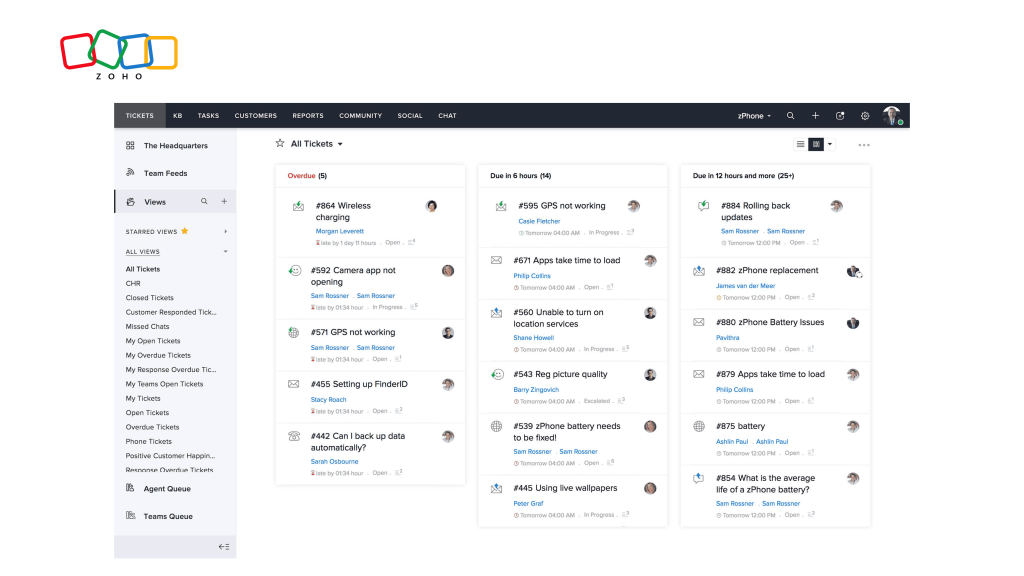
If you’re looking for a help desk tool that understands context, Zoho Desk might become your new trusty companion. It assists you in providing smooth customer service using intelligent ticket management and multi-channel support.
The tool is combined with the entire Zoho ecosystem, allowing you to connect it with applications such as Zoho CRM and Books. This creates better teamwork and gives agents the full picture of every customer.
However, if your team doesn’t already use Zoho products, setup and integration might feel a bit clunky. Also, while it covers the basics well, some advanced analytics and customization options are limited unless you opt for higher-tier plans.
Key Features:
- Zia AI offers emotion detection, smart tags, and more to refine responses
- Multi-channel ticketing (email, chat, social, web, phone)
- Custom SLAs and workflows
- Context-aware customer timelines
- Self-service portal and knowledge base
- Team collaboration tools like chat and tags
- Advanced escalation and approval rules
- Integration with over 200 third-party apps
Pros:
- Native integration with other Zoho tools
- User-friendly for growing support teams
- Affordable for small to mid-sized businesses
Ideal Use Cases:
- Manage customer queries with CRM-linked insights
- Automate routine tasks with AI-based workflows
- Create multilingual knowledge bases for global users
- Monitor team performance with SLA dashboards
HelpCrunch blends live chat, email automation, and a knowledge base into one platform. It’s designed for companies looking to develop strong, reactive customer connections. You can interact with users instantly, send specific follow-ups, and lower ticket volume via self-service options.
8. HelpCrunch
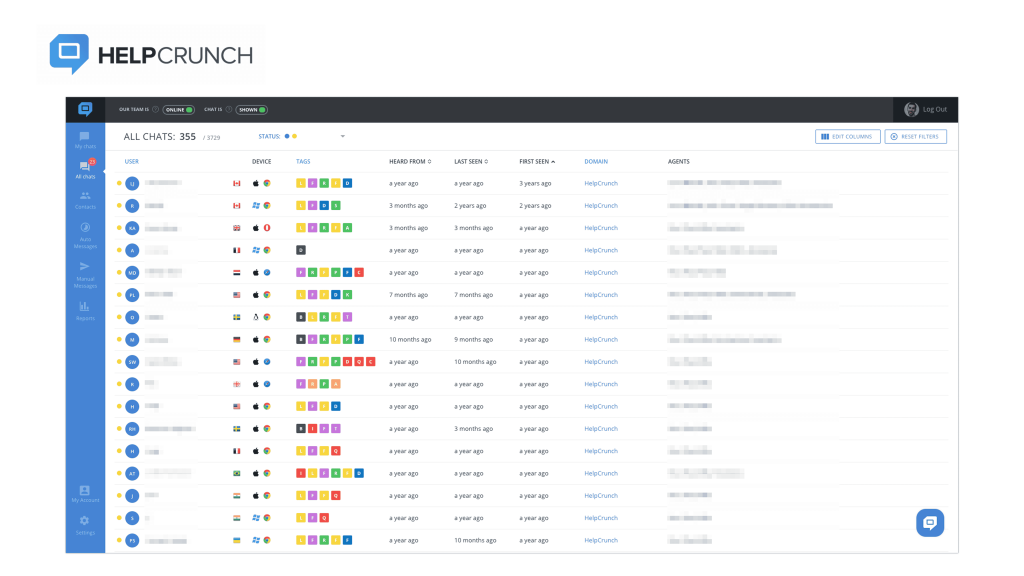
Its interface is modern, intuitive, and quick to deploy. If speed and design matter to you, this is a strong pick. Nevertheless, the reporting features of the tool are still developing and might fall short of the expectations of data-focused teams seeking comprehensive insights or corporate-level dashboards. It’s most appropriate for small to medium teams that value engagement more than complexity.
Key Features:
- Multichannel inbox (chat, email, popup forms)
- Proactive and behavior-based live chat triggers
- Customizable help center
- Pre-chat forms and offline messaging
- Chat transcripts and conversation ratings
- In-app messaging for mobile/web apps
- Seamlessly connects with your CRM and CMS systems
Pros:
- Excellent UI/UX for agents and customers
- Fast and smooth live chat experience
- Easy to set up and scale for small teams
Ideal Use Cases
- Boost website conversions with proactive chat
- Engage app users through in-app messaging
- Automate email responses post-chat
- Build and update your own branded help site with ease
9. Olark
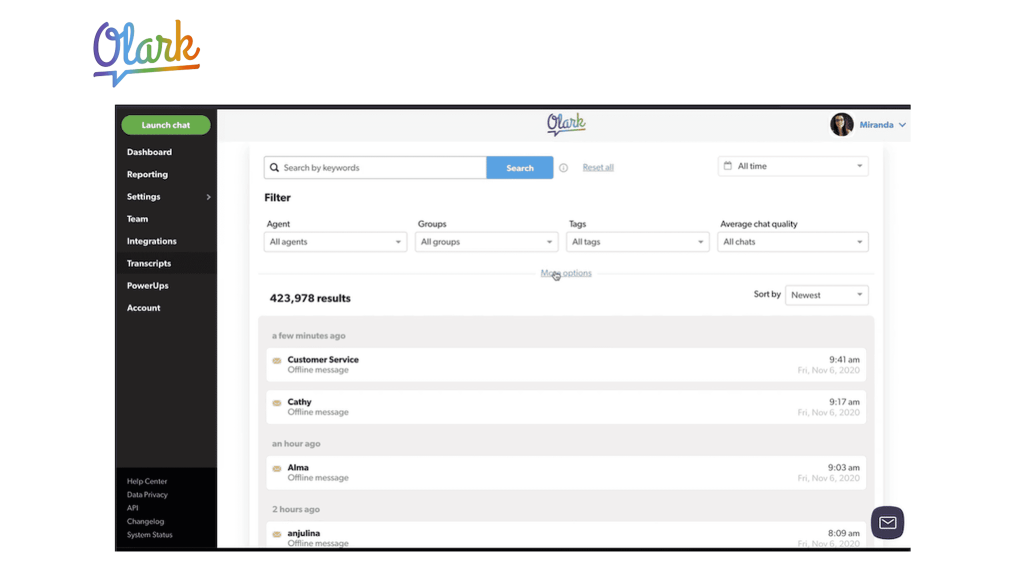
If simplicity and live chat are your priorities, Olark fits the bill. It helps you connect with customers in real-time and gather insights right from your website. You can monitor visitor behavior, create chat transcripts, and even trigger chats based on user activity.
Its clean interface and ease of use make onboarding effortless, especially for small teams. You’ll also find robust reporting and CRM integrations to streamline follow-ups.
Nonetheless, Olark is heavily chat-focused, and if you’re looking for multichannel capabilities or native email and knowledge base support, you may feel slightly limited. It’s best suited as a pure live chat tool rather than a full-fledged support suite.
Key Features:
- Real-time live chat with visitor insights
- Custom chatbox with branding options
- Pre-chat surveys and automated greetings
- In-depth chat analytics and reporting
- Offline messaging and email forwarding
- Chat transcripts and searchable archives
- CRM and help desk integrations
- Targeted chat rules for engagement
Pros:
- Quick setup and beginner-friendly
- Clean and responsive chat interface
- Strong customization for branded experiences
Ideal Use Cases:
- Provide instant support to website visitors
- Capture leads via proactive chats
- Understand user behavior through chat data
- Automatically direct chats to the right team using routing rules
10. Drift
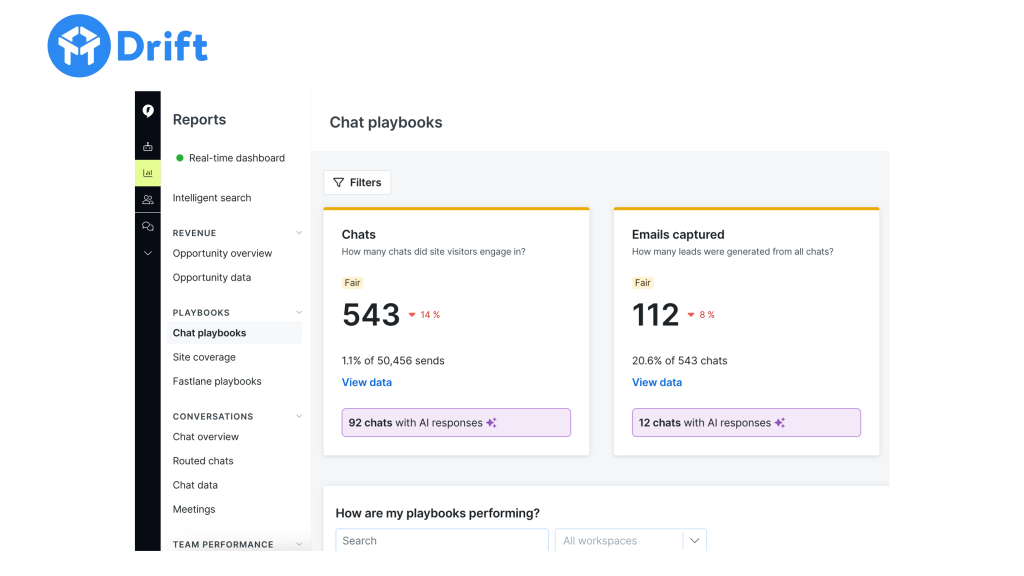
Drift is built for teams that want to merge customer service with real-time revenue growth. Known for its conversational marketing approach, Drift helps you turn live chats into meaningful business conversations.
You can identify high-value site visitors, trigger AI-powered chatbots, and schedule demos directly through the chat window. A strong fit for teams looking to align service and sales under one roof. Drift also provides deep account-based insights, making it valuable for B2B support teams.
That said, its advanced features are often locked behind premium pricing, which may not work for budget-conscious support teams. Smaller businesses might find it too sophisticated for basic service needs.
Key Features:
- Conversational AI for real-time chat
- Chat-to-call or meeting scheduling
- Account-based routing and targeting
- Custom chat playbooks for lead capture
- Real-time alerts for high-intent visitors
- CRM and email marketing integrations
- Multilingual chatbot support
- Video and voice messaging in chat
Pros:
- Aligns sales and service into one flow
- Powerful targeting and personalization
- High-quality AI-driven engagement
Ideal Use Cases:
- Guide high-intent leads with personalized chats
- Qualify and route enterprise customer queries
- Improve B2B onboarding with proactive messaging
- Offer sales-driven customer support via bots
11. HubSpot Service Hub
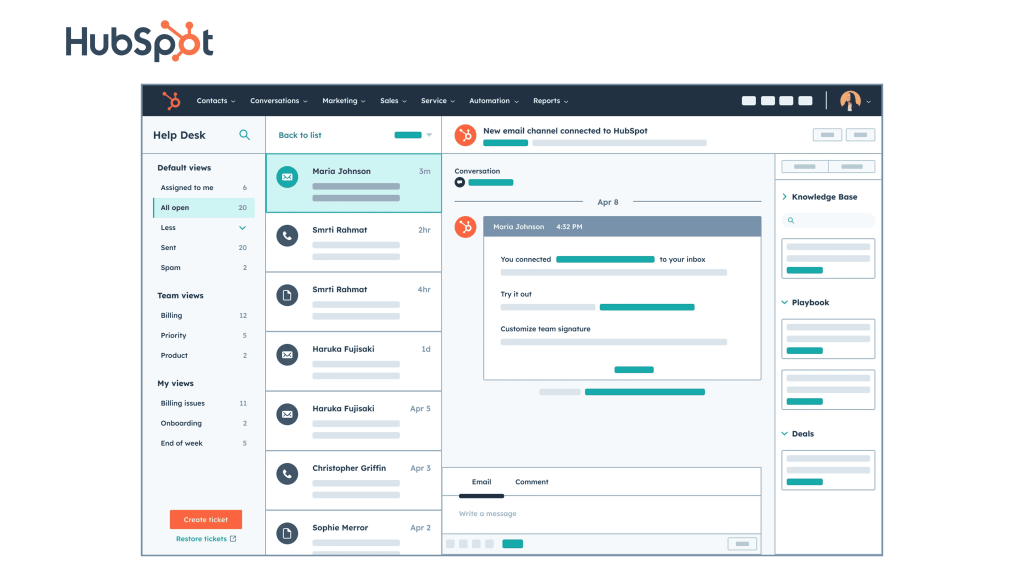
HubSpot Service Hub offers you a robust set of tools for handling customer relationships and addressing problems effectively. It combines ticketing, automation, live chat, and a unified inbox to guarantee your support team stays consistently engaged. Its strength lies in unifying customer data across the platform, making the service deeply personalized.
You’ll also benefit from a knowledge base builder, customer feedback tools, and robust analytics. The best part? Everything ties into the larger HubSpot ecosystem.
But if you’re not already using other HubSpot tools, the onboarding and pricing structure can feel a bit overengineered for just customer service needs. It’s a great option for teams already invested in the HubSpot ecosystem, but may be excessive for simpler workflows.
Key Features:
- Omnichannel ticketing with automation
- Shared inbox for support teams
- Knowledge base with SEO-friendly design
- Customer satisfaction and NPS surveys
- Custom SLAs and ticket routing
- Live chat and chatbot builder
- Reporting dashboards and performance insights
- Seamless CRM integration
Pros:
- Strong automation and ticket management
- Deep customer insights across tools
- Intuitive user interface
Ideal Use Cases:
- Manage large volumes of customer queries
- Automate repetitive support workflows
- Build a searchable self-service knowledge base
- Track team performance and satisfaction
12. Tidio
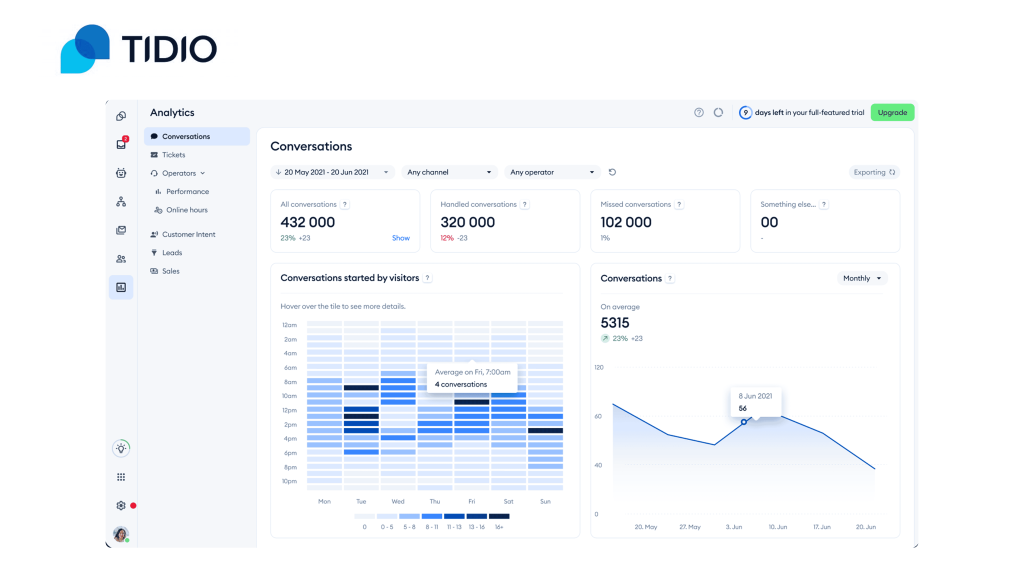
Tidio is worth considering if you aim to offer automated real-time customer support. It merges various channel tools, bots, and real-time chat into one unified solution. Tidio stands out for its user-friendly chatbot builder, quick setup, and integration with Shopify and WordPress.
Regardless of whether you assist customers through email, Messenger, or Instagram, Tidio allows you to handle everything from a single dashboard. The AI chatbot is particularly useful for managing repetitive inquiries around the clock.
Although Tidio is effective for basic support requirements, it might not suffice for more intricate ticketing or escalation procedures typically needed by larger groups. Still, for small to medium-sized teams, it remains a budget-friendly option.
Key Features:
- Multichannel support (email, chat, Messenger, Instagram)
- AI-powered chatbot builder
- Unified inbox for all customer interactions
- Pre-built chatbot templates for FAQs
- Customizable live chat widget
- Real-time visitor monitoring
- Offline messaging with follow-up options
- Integrations with CRM, CMS, and eCommerce tools
Pros:
- Easy to set up and customize
- Affordable for small businesses
- Great chatbot automation for common queries
Ideal Use Cases:
- Provide 24/7 customer support with bots
- Manage multichannel inquiries from one dashboard
- Support eCommerce customers pre- and post-purchase
- Reduce support load with automated responses
13. Kayako
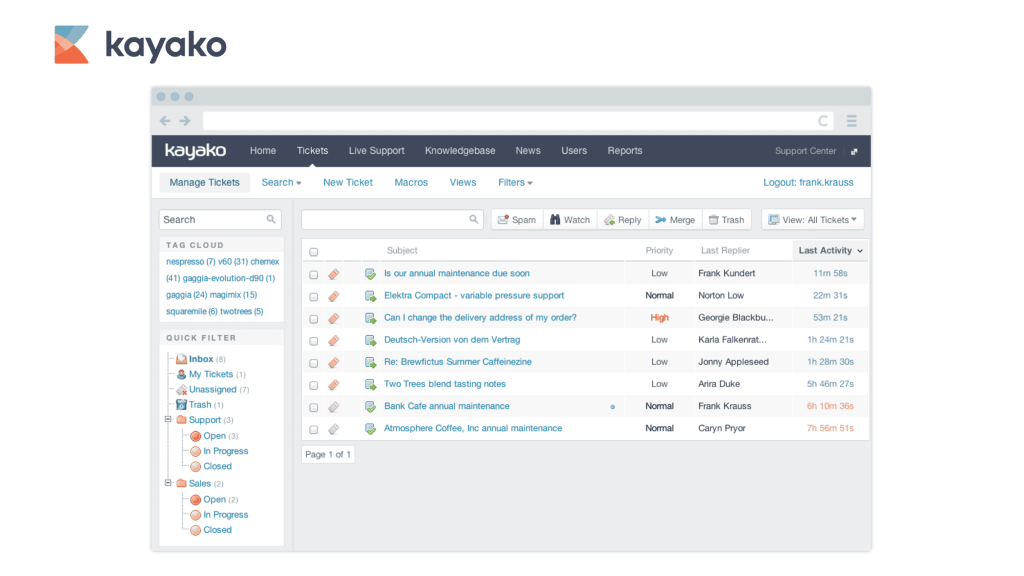
Kayako is a customer service platform built for seamless omnichannel support. What sets Kayako apart is its ability to deliver a complete customer journey view — every interaction, across every channel, in one thread. This context helps your support agents respond faster and with better accuracy.
Its shared inbox and collaboration tools boost team productivity, making it easier to resolve complex queries. While Kayako excels at cross-channel support, it may not scale well for teams seeking deeper automation or highly customizable workflows. That said, it’s a solid choice for businesses focused on relationship-based customer service without needing heavy technical setups.
Key Features:
- Unified customer journey timeline
- Centralized support across email, chat, social media, and a self-help portal
- Shared team inbox and internal notes
- Live chat with visitor insights
- Custom ticket workflows and SLAs
- Self-service help center creation
- Real-time customer activity tracking
- Basic automation for repetitive tasks
Pros:
- Great omnichannel experience
- Strong focus on collaboration
- Easy-to-understand customer timeline
Ideal Use Cases:
- Support teams needing customer journey context
- Businesses handling multi-channel interactions
- Service teams focused on real-time responses
- Startups needing a simple help desk
14. Crisp
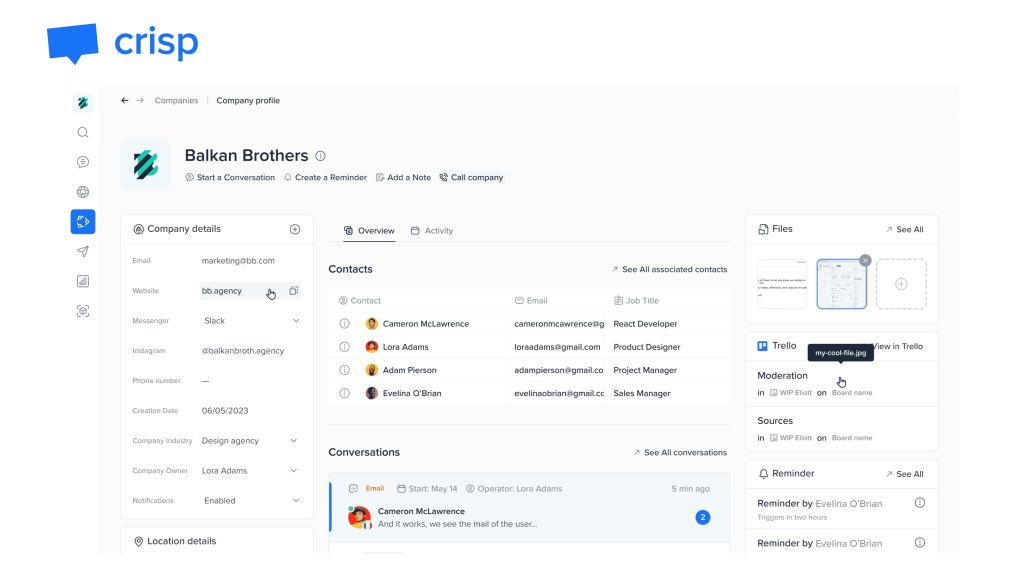
Crisp is a modern, all-in-one customer service platform designed to streamline real-time communication across live chat, email, social messaging, and chatbots. Its intuitive interface and quick setup make it ideal for startups and growing businesses looking to centralize support without complexity.
Notably, its standout features include co-browsing (browsing a webpage together with a customer) and shared inboxes for team collaboration. With built-in automation tools and integrations with platforms like Shopify and WordPress, Crisp supports proactive engagement and efficient workflows.
Nevertheless, it may not fully meet the needs of teams requiring detailed ticketing, advanced escalation paths, or SLA enforcement. Crisp is best suited for businesses that value conversational support and customer engagement over heavy-duty service infrastructure.
Key Features:
- Supports various messaging channels like Messenger, live chat, and email
- Shared inbox for support collaboration
- Co-browsing for real-time guidance
- Chatbot builder for automated replies
- Knowledge base for self-service
- In-app messaging and triggered campaigns
- Real-time visitor monitoring
- CRM and eCommerce platform integrations
Pros:
- Visually appealing and easy to use
- Effective for small-to-medium teams
- Great for proactive support messaging
Ideal Use Cases:
- Provide real-time, in-app support
- Assist customers through co-browsing
- Use chatbots to automate FAQs
- Manage customer queries from one place
15. tawk.to
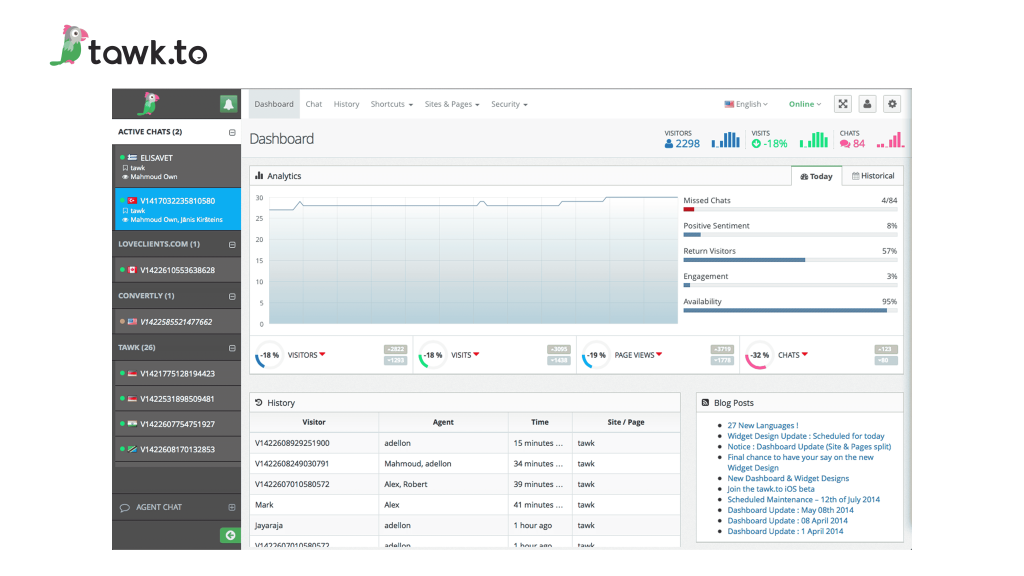
If you’re looking for a cost-effective way to supercharge your customer service, tawk.to is a strong contender. It’s a free live chat software that allows you to monitor and chat with customers in real time.
With support for over 45 languages, it’s ideal for businesses with global reach. The clean dashboard, built-in ticketing, and visitor tracking tools make it easier to handle customer queries efficiently. Also, you can also hire live agents directly from the platform if you lack internal support staff.
While tawk.to offers excellent value for startups and small teams, it does come with limitations. Advanced analytics, customization, and integrations are relatively basic compared to more premium Intercom alternatives. If you’re scaling fast or need deep automation, it might feel restrictive.
Key Features:
- Free live chat with unlimited agents
- Built-in knowledge base and help desk
- Real-time visitor tracking and engagement
- Canned responses and shortcuts
- Mobile app for on-the-go support
- Widget customization options
- Group messaging and agent monitoring
- Hire live agents via the marketplace
Pros:
- Completely free to use
- Quick and easy setup
- Supports multiple languages
- Offers agent hiring flexibility
Ideal Use Cases:
- Startups with tight support budgets
- Businesses needing live chat in multiple languages
- Teams looking for human agent outsourcing
- Companies wanting real-time customer engagement without software overhead
Why Businesses Look for Intercom Alternatives?
As customer service grows complex, many companies seek alternatives to Intercom that better align with their evolving needs.
1. Rising Costs, Declining Returns
Intercom’s pricing scales aggressively. You pay more as your contacts grow. AI features come at an extra cost, and additional charges often show up unexpectedly.
One G2 reviewer criticized Intercom’s pricing as confusing and misleading, saying a needed feature unexpectedly increased their costs fivefold mid-migration. For finance and CX leaders, this raises concerns about the platform’s long-term sustainability and ROI.
2. Support Feels Like an Afterthought
Intercom addresses various uses—including marketing, product development, and customer support. This “jack-of-all-trades” method frequently lacks depth in fundamental customer service aspects such as SLA monitoring, escalation routes, and omnichannel integrations, which are vital for service-oriented organizations.
3. Clunky Workflows, Slower Responses
Intercom’s inbox can feel cluttered and unstructured. Features like tagging, workflow routing, or multi-team collaboration don’t always function smoothly, leading to missed messages, longer resolution times, and agent burnout.
4. Inconsistent Support from a Support Platform
Ironically, Intercom’s own support can be underwhelming. Users report long wait times, inconsistent answers, and a lack of urgency—especially during critical service disruptions. This undermines trust and slows down issue resolution.
What to Look for in Intercom Alternatives?
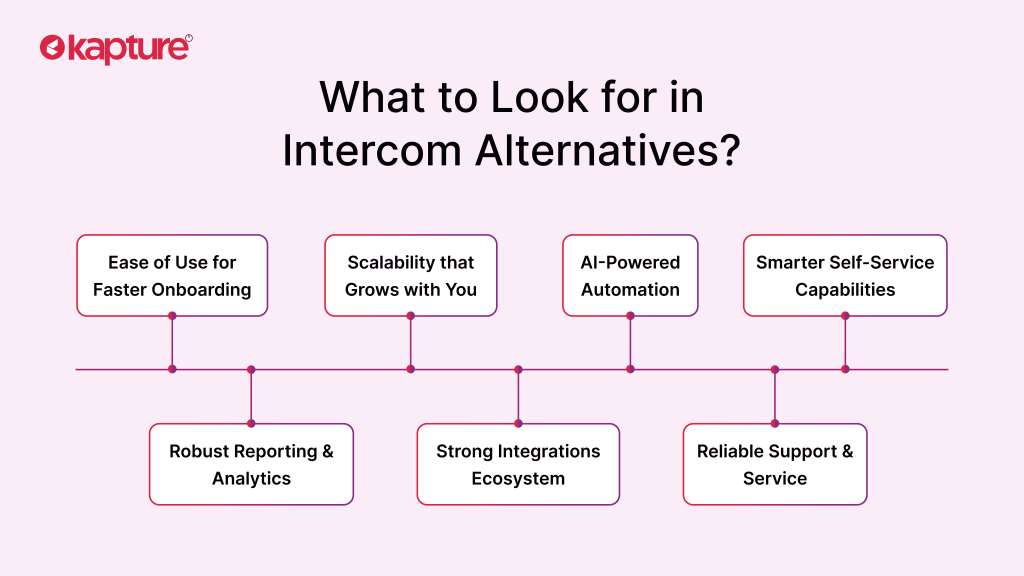
Switching platforms isn’t just about cost. You need the right platform to deliver standout customer experiences.
1. Ease of Use for Faster Onboarding
You shouldn’t need weeks of training. Great Intercom alternatives should be intuitive, with a clean interface. Prioritize tools with easy drag-and-drop setup, flexible dashboards, and user-friendly design. If your agents aren’t using the tool efficiently within days, it’s already costing you time and satisfaction.
2. Scalability that Grows with You
As your business grows, your support solution should grow with it. Choose tools that offer predictable pricing and handle high volumes without lag. A platform that buckles under pressure won’t just frustrate your agents—it’ll cost you customer trust.
3. AI-Powered Automation
According to Gartner, AI will handle 80% of routine service requests autonomously by 2029, cutting costs by 30%. The message is clear: automate or fall behind.
Modern platforms now use AI for ticket routing, contextual suggestions, and instant replies. The result? Faster resolutions and fewer escalations.
Multiple telecom brands, for instance, significantly reduced response times after automating first-level queries, leading to noticeably faster support for customers. It’s not just about efficiency—it’s about staying future-ready.
4. Smarter Self-Service Capabilities
Customers expect quick answers without always needing an agent. While Intercom offers help articles, it lacks advanced self-service features like AI-driven suggestions, intent-based search, or dynamic FAQs. The best alternatives help users help themselves—reducing ticket volume and improving satisfaction at scale.
5. Robust Reporting & Analytics
Data drives decisions. Real-time analytics, SLA monitoring, and trend tracking are must-haves for modern support. Avoid tools that hide insights behind paywalls or clunky exports. Your CX team should have clear visibility into what’s working—and what’s not—to make improvements daily.
And the payoff is real: an HBR survey found that 85% of businesses using customer analytics saw improvements in their customer experience.
6. Strong Integrations Ecosystem
Support doesn’t work in isolation. Choose platforms that connect effortlessly with your CRM, ticketing tools, knowledge base, and marketing stack. Native and open API integrations reduce manual work and give agents the full picture, every time they respond.
7. Reliable Support & Service
Some Intercom competitors now outperform it when it comes to customer support. Look for fast response times, dedicated success managers, and transparent SLAs. When things go wrong, you need a vendor who acts fast—not one who leaves you waiting.
Choosing Right Intercom Alternatives
The right Intercom alternatives depends on your team’s needs, size, and growth goals. Pick a platform designed to scale alongside your business.
1. Map your requirements to your CX objectives
If your priority is reducing response times or automating tickets, look for tools with AI-driven automation and omnichannel routing. For deeper customer insights, prioritize platforms that offer unified views and smart analytics tailored for customer service teams.
2. Start with your team size and volume
Small teams need easy setups and intuitive dashboards. Mid-size teams may require integrations and workflows. Large enterprises need advanced features like SLAs, custom roles, and robust reporting. Always pick a platform that won’t slow your agents down.
3. Consider industry-specific features
eCommerce? Go for Shopify integrations and macros. SaaS? Choose tools with product tours and knowledge base support. B2B services? Look for advanced workflows, multi-language support, and strong CRM integration. Each industry has unique support challenges—match your tool to them.
4. Factor in your CX budget
Don’t pay for features you won’t use. Free or low-cost tools like tawk.to or Crisp work well for small teams. If you’re scaling, invest in platforms like Kapture CX that balance automation, usability, and cost-effectiveness without bloated functionality.
5. Test before committing
Almost every alternative to Intercom offers a trial. Use it. Test core features. Check integration speed. Validate usability with agents. Therefore, let your support team test-drive the tool—they know what they need better than anyone else.
Ready to Find the Right Fit for Your Team?
Choosing a customer service platform isn’t just about replacing Intercom. It’s about finding a tool that fits your workflows, scales with your business, and puts customers first.
Kapture CX offers:
- Vertical AI for your industry
- Omnichannel support from email to social
- AI-powerd Agent Co-Pilot & Smart Ticketing
- GenAI Knowledge Base for self-serve
- Seamless third-party integrations
Moreover, these features empower your team to resolve queries faster, boost CSAT, and drive lasting loyalty. If you’re looking to evolve beyond traditional tools, Kapture is built for you.
Don’t just replace Intercom—outperform it. Book your free Kapture demo today!
FAQs
Good Intercom alternatives should offer robust automation, multichannel support, easy integrations, and flexible pricing tailored to your support needs and business size.
Most platforms offer assisted onboarding or migration tools. With support from your new provider, you can export Intercom data and import it into your alternative to Intercom.
Absolutely. Tools with AI-powered suggestions, canned responses, and unified inboxes help agents resolve tickets faster and stay focused on high-priority issues.
